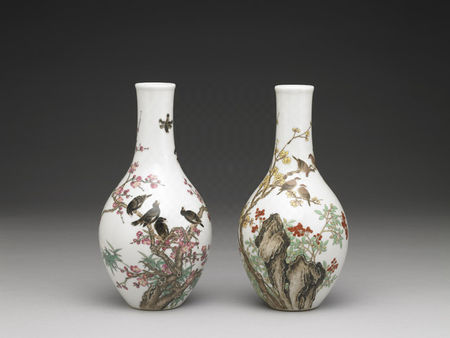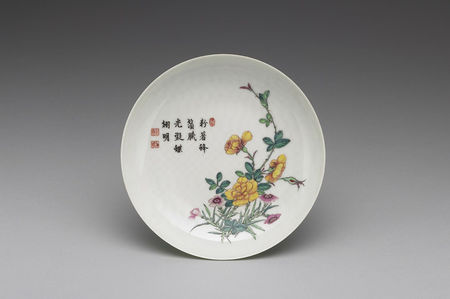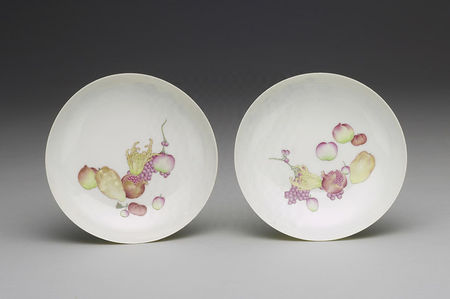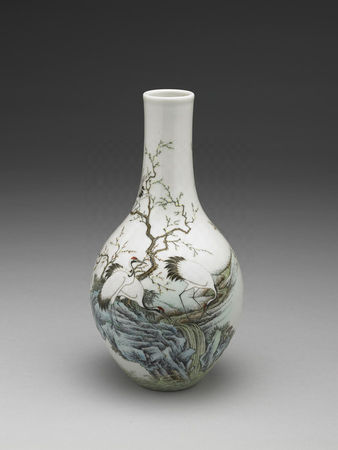'Stunning Decorative Porcelains from the Qianlong reign' @ National Palace Museum
Pair of soup bowls in yang-ts'ai enamels with incised red ground pattern of flower brocade and landscape décor © National Palace Museum
The fa-lang-ts'ai porcelains in the collection of the National Palace Museum can be divided into two categories, painted fa-lang-ts'ai porcelains and yang-ts'ai porcelains. Masterpieces of unprecedented quality, these works had earned themselves the favor of the Ch'ien-lung emperor. During his reign, they were kept in the Ch'ien-ch'ing-kung Palace, where the emperor would admire them. The present exhibition concentrates on yang-ts'ai porcelains, although a number of fa-lang-ts'ai porcelains are also on view to demonstrate the differences between the two.
The Museum has in its collection more than five hundred fa-lang-ts'ai porcelains, with the majority made between the 5 th and 9 th years of the Ch'ien-lung reign(1741-1744). They are, in fact, a manifestation of the emperor's vibrancy and confidence in the early years of his 60-year reign, a period of great achievement in many spheres, as well as in the arts. At the request of the emperor, the supervisor of the imperial kilns at Ching-te-chen by the name of T'ang Ying(1682-1756) personally oversaw the production of the imperial wares twice a year, in the spring and then again in the autumn. It was here that T'ang developed a continuous line of innovative techniques to please his emperor, to produce porcelains which would be admired as "the work of the gods," such as the openwork revolving vases. It was also T'ang Ying that developed the "pattern of flower brocade" technique of incised decoration, which brought out the best in the enamel colors of yang-ts'ai. T'ang Ying was also the first to employ the term yang-ts'ai to refer to these porcelains. The Chinese character yang hints at the connection to the West, as it means "ocean" and, by extension, objects from overseas. Also, the decoration on these porcelains employed Western painting techniques. The yang-ts'ai porcelains had the personal stamps of Ch'ien-lung all over them, bearing poetry composed by his own hand as well as imperial seals belonging to him. Clearly, then, the Ch'ien-lung emperor greatly admired these porcelains, and perhaps even saw them as an innovative style adequately reflecting his reign when at the height of his powers.
Both yang-ts'ai and fa-lang-ts'ai porcelains used fa-lang enamel glazes, and this accounts in some way for the confusion that has surrounded them for many years. In fact, there are differences between the two in terms of where and how they were manufactured, as well as the decoration, poetry, seals and reign marks used. In the early Republican period the confusion was further exacerbated by the identification of the yang-ts'ai porcelains with the term fen-ts'ai. This exhibition will not only show 110 examples of yang-ts'ai porcelains, it will also seek to clarify the differences between yang-ts'ai and painted fa-lang-ts'ai porcelains, and clear up the confusion over the issue of fen-ts'ai wares.
Pair of dishes in fa-lang-ts'ai enamels with painting pattern of flower brocade and figures décor © National Palace Museum
The vast majority of yang-ts'ai porcelains and painted fa-lang-ts'ai porcelains kept in the Ch'ien-ch'ing-kung Palace were made in pairs. However, whereas both pieces in the yang-ts'ai pairs were virtually identical in their shape, decoration, composition and the details, the fa-lang-ts'ai pairs had slight differences in decoration. This is one of the ways in which the two types of porcelain can be distinguished from each other.
Pair of gall-bladder vases in yang-ts'ai enamels with incised blue ground pattern of flower brocade and band décor © National Palace Museum
Pair of gall-bladder vases in fa-lang-ts'ai enamels with sparrow and mynah bird décor © National Palace Museum
What are yang-ts'ai porcelains? According to T'ang Ying, supervisor of the imperial kilns, they are "porcelains on which a new technique borrowed from Western painting method is used." He also said that they were "white ceramics with paintings in wu-ts'ai colors, using Western techniques, hence the name." They were porcelains with outstanding paintings of figures, landscapes, flowers and plumage, using painting techniques from the West. The Archives of the Imperial Workshops of the time classify them as "fa-lang enamel ceramics in the Ch'ien-ch'ing-kung Palace," and the Ch'ing Court Inventories list both yang-ts'ai and fa-lang-ts'ai porcelains as "ceramics bearing Ch'ien-lung's seals." Clearly, then, the two types were closely associated with each other. Yang-ts'ai porcelains are classed as fa-lang-ts'ai enamel wares, and are painted porcelains employing Western painting techniques and décor.
Square vase in yang-ts'ai enamels on yellow ground with western floral décor © National Palace Museum
Ku vase in yang-ts'ai enamels with plantain leaves décor on yellow ground © National Palace Museum
1.The Introduction and Incorporation of Western Elements
From Ch'ing historical archives and actual examples we can identify the following criteria which qualify a piece of porcelain as yang-ts'ai:
(1) The use of Western shading techniques, especially in the rendering of the décor on the porcelains to give the body a three-dimensional quality.
(2) The use of white pigment on many of the leaf patterns on the flower illustrations, to represent light and shadow (a painting technique rarely seen on the painted fa-lang-ts'ai porcelains).
(3) The reliance on Western shading and perspective painting techniques on figurative compositions.
(4) The use of Western-style flowers, such as the chrysanthemum and anemone, and the liberal use of Western floral compositions for a number of decorative patterns.
Vase in yang-ts'ai enamels with décor of western floral and fungus © National Palace Museum
Gall-bladder vase in yang-ts'ai enamels with figures décor © National Palace Museum
2.Traditional Court Decoration Accompanied by Ch'ien-lung's Own Poetry and Seals
The yang-ts'ai porcelains were decorated with traditional Chinese landscape paintings together with floral decoration, predominantly with realistic paintings of flowers representing the four seasons, mixing white enamel pigments to create a more varied palette of tones. Stylistically, these paintings were similar to those of contemporary court painters, and the styles could be traced back to the flower paintings of the T'ang and Sung dynasties. Although one can see great similarities between the floral décor on both yang-ts'ai and fa-lang-ts'ai porcelains, the poems and seals used to decorate the two types were completely different. On fa-lang-ts'ai porcelains most of the poems and seals dated as far back and the T'ang and Sung, whereas with yang-ts'ai porcelains the selection of poems was mostly from Ch'ien-lung's oeuvre. The seals, too, were the emperor's.
Mei-p'ing vase in yang-ts'ai enamels with imperial poem and chrysanthemum décor © National Palace Museum
Mei-p'ing vase in yang-ts'ai enamels with imperial poem and chrysanthemum décor © National Palace Museum
Dish in fa-lang-ts'ai enamels on green ground with incised pattern of flower brocade and flowers of the four seasons décor © National Palace Museum
3.The Pattern of Flower Brocade Décor and Technique
The pattern of flower brocade began to be used on large amounts of painted fa-lang-ts'ai and yang-ts'ai porcelains in the 5 th and 6 th years of the Ch'ien-lung reign (1740-1741). This involved the application of decorative motifs over a dense brocade pattern on the surface of the porcelains. There were two types of brocade ground, the incised and painted forms, with the former involving incising intaglio lines and the latter being raised above the surface. These two techniques were used to create intricate brocade patterns of floral patterns, the wan (卍) character, floral roundels, hexagonal tortoiseshell, square calyx patterns and floral scrolls, as well as lotus petal patterns, geometric fret patterns and auspicious cloud patterns to decorate the borders and edging. This period represented the apogee of incised brocade work. All of the empty spaces and borders on examples seen in this exhibition, such as the openwork revolving vases, were filled with this type of brocade pattern, and it was to this that the term "pattern of flower brocade" referred. It was, in fact, one of the main features of T'ang Ying's yang-ts'ai porcelains.
Lidded spittoon in yang-ts'ai enamels with incised pattern of flower brocade © National Palace Museum
Vase in yang-ts'ai enamels with incised red ground pattern of flower brocade and butterfly décor © National Palace Museum
Teacup in yang-ts'ai enamels with incised blue ground pattern of flower brocade © National Palace Museum
Pair of small dishes in fa-lang-ts'ai enamels on yellow ground with incised pattern of flower brocade © National Palace Museum
4.Openwork Revolving Vases: the Work of the Gods
T'ang Ying, the supervisor of the imperial kilns, knew that Ch'ien-lung wished to preside over a renaissance in the arts, and he devoted his energies to creating innovations that would satisfy the emperor. The yang-ts'ai porcelains he created started to become more intricate from 1742, the 7 th year of the reign, onwards. The artisans at Ching-te-chen became adept at openwork carving, revolving parts, multilayered designs and complex decoration. These involved complex and difficult production processes, presenting the artisans with considerable challenges. The openwork revolving vase featured in the exhibition was to be lauded as the "work of the gods." In a memorandum presented to the emperor in 1743, T'ang Ying informed Ch'ien-lung that he had developed nine new designs, and all of these can be found among the yang-ts'ai porcelains in the Museum's collection.
Revolving gourd vase in yang-ts'ai enamels with Chang-kuan glaze and golden bats, clouds décor © National Palace Museum
Revolving bowl in yang-ts'ai enamels with landscape and imperial poem décor © National Palace Museum
Revolving openwork vase in yang-ts'ai enamels, with fish and aquatic plant décor, painted blue ground and gold tracery © National Palace Museum
There are entries to the yang-ts'ai porcelains in the Museum's collection in the Archives of the Imperial Workshops, the Court Inventories and T'ang Ying's memoranda to the emperor. A detailed review of these materials allows us to find out the time and place of manufacture, title and other information about the ceramic works. Before they were sent to the Ch'ien-ch'ing-kung Palace to be put on display, they would have had boxes made for them. Their titles would have been carved onto these boxes, and it is from here that we have obtained the names of the porcelains for this exhibition.
Kuan-yin vase in yang-ts'ai enamels with Indian lotus décor on cream-coloured glaze © National Palace Museum
Gall-bladder vase in yang-ts'ai enamels with cranes and plum blossom décor © National Palace Museum
The firing process used to create the pattern of flower brocade effect was very complex. First, the ceramic body was fired at a high temperature, and then the pattern would have been created over three or more successive firings at a lower temperature. The procedure was as follows:
1. Mold the clay into shape
2. Apply the reign mark with cobalt-based pigment
3. Cover with transparent glaze
4. Fire the biscuit in high temperature
5. Cover with red overglaze enamel and incised scrolling leaf pattern
6. Fire again to fix the incised pattern of flower brocade on red ground
7. Paint the landscape and flower décor over the enamels glaze
8. Fire again to fix the enamels glaze
This was the procedure used to fire the modern work, the soup bowl in yang-ts'ai enamels with pattern of flower brocade and landscape décor on a red ground.
國立故宮博物院著作權所有 Copyright © National Palace Museum. All Rights Reserved.

/https%3A%2F%2Fprofilepics.canalblog.com%2Fprofilepics%2F1%2F0%2F100183.jpg)


























/http%3A%2F%2Fstorage.canalblog.com%2F31%2F55%2F577050%2F66184124_o.jpg)
/http%3A%2F%2Fstorage.canalblog.com%2F68%2F63%2F119589%2F66179442_p.jpg)
/http%3A%2F%2Fstorage.canalblog.com%2F15%2F05%2F577050%2F65768905_o.jpg)
/http%3A%2F%2Fstorage.canalblog.com%2F92%2F30%2F119589%2F65585173_p.jpg)